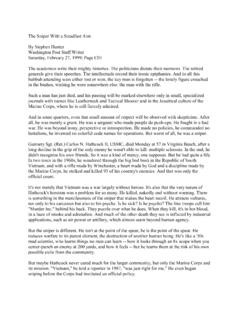Transcription of Post Exposure 2nd - Ctein
1 This book is dedicated to Ray Bradbury, without whose encouragement I would not have become the photographer I am today. It doesn't matter how you get there, if you don't know where you're going. The Flying Karamazov Brothers C ONTENTS. Preface xi Acknowledgments xii Introduction xiii CHAPTER 1 How We See 1. Sharpness 1. Our Vision of Tonality 4. How We See Color 8. Photometamerism 10. Choosing the Right Lighting for Viewing Prints 12. CHAPTER 2 How the Film Sees 13. Luminosity 13. Color 19. Saturation vs. Contrast 24. Choosing Between Slides and Negatives 27. Photographing for Reproduction in Color 29. CHAPTER 3 Calibrating Films and Exposure Meters for Light and for Color 31. How Errors Creep In 31. Metering and the Myth of 18% Gray 33. The Macbeth Chart 36. vii CHAPTER 4 How Print Materials See 37.
2 Sharpness 37. The Exposure Range of Print Materials 38. Determining the Exposure Range and Tonal Qualities of Print Materials 39. Converting Print Exposure Range to Subject Exposure Range 40. Paper Differences as Seen in Pictures 42. How Important Is Print Density Range? 45. Paper Differences as Seen in Step Tablets 46. CHAPTER 5 Matching the Characteristics of the Film and the Print Material 51. Fiber vs. Resin-Coated Black and White Papers 55. Veiling 55. Tonal Range 55. Permanence 56. CHAPTER 6 Enlarging Issues 57. Condenser vs. Diffusion Light Sources 57. The Big Questions 59. Flare 59. Uniformity 61. Color Printing 62. B&W Print Sharpness 64. Contrast and Tonal Placement 66. How Sharp Does a Lens Have to Be? 70. It's Not All Resolution Figures 74. Grain-Focuser Gotchas 76. The Best Enlarging Lenses in the World 77.
3 The Tech-Free Version 78. The High-Tech Version 79. Sharpness 79. Illumination 79. Is It Flat? 80. Picking Out a Lens 80. What Focal Length Is Right? 80. Apo Is as Apo Does 81. An Unfortunate Omission 82. Misalignment Blues 82. How to Test Lenses 83. Light Falloff 83. Distortion 84. Flare 84. Advanced Tests 84. Resolution and Contrast 85. Lens Element Centering 85. viii Contents Field Flatness 86. Ratings of the Best Enlarging Lenses 88. CHAPTER 7 Prints from Slides vs. Prints from Negatives 91. Differences in Tonal Rendition 92. Differences in Color Rendition 93. Differences in Permanence 94. Issues with Ilfochrome 94. CHAPTER 8 Contrast Control in Color 97. Changing Color Films' Contrast 98. Color Paper Grades 99. Fogging to Reduce Contrast 100. Color-Film Masking 101. Making Masks for Negatives 103.
4 Using SoftShot Developer with TMAX 100 Film 104. Making the Masks 105. Masking with Polaroid 107. Masking Transparencies 107. Going Up! 108. Printing with a Mask 109. Controlling Ilfochrome Contrast with Processing 110. CHAPTER 9 Tricks of the Trade 113. Save a Tree: Learn to Print 113. Keep Those Negatives Popped 116. Dodging and Burning-in Using Litho Film Masks 116. Making Black and White Prints from Color Negatives and Slides 118. How to Process Black and White Prints in Color Processors 123. Control Strips 124. RA-4 Strips 125. R-3 Strips 126. Room Temperature RA-4 and R-3000 127. How to Remove Black Spots from Black and White and Color Prints 128. More About Spotting 128. Effect of Drying on Color and Contrast in Black and White Papers 129. Gotchas 130. Poor Reversal Print Washing 130.
5 Selenium Toning Eccentricities 130. Safelight Fogging 131. VC Filters Fade 132. What About Dye Transfer? 132. Contents ix CHAPTER 10 Useful Tools 133. Denglas 133. Edwal No Scratch 133. Jobo Processor Clean II 134. Microfibre Lens Cloth 134. PEC-12 and PEC Pads 134. Photofinish 135. Sistan 136. Stouffer Step Tablets 136. Tetenal Anti Newton Spray and Film Cleaner Spray 136. Zig-Align Alignment Systems 137. CHAPTER 11 Special Concerns of Variable-Contrast Paper Users 139. Split-Filter Printing vs. Graded Filter Printing 139. Above or Below the Lens? 144. Differences in Image Quality Between Variable-Contrast and Graded Papers 144. Focusing Problems Specific to Variable-Contrast Papers 145. Identifying the Culprit 148. What Can We Do? 154. CHAPTER 12 The Issue of Permanence 155. Are Black and White Resin-Coated Papers as Permanent as Fiber Papers?
6 158. Background on RC Permanence 159. Grass-Roots Experimentation 160. What We Don't Know 163. On the Other Hand 164. What Can We Conclude? 164. Presentation Factors That Affect Permanence 167. CHAPTER 13 My Darkroom 169. Index 173. x Contents P REFACE. Ansel Adams observed that the film is the score and the print is the performance. When I. exhibit my best prints to an appreciative audience, I feel akin to the Wizard of Oz. Dorothy and her companions were supposed to see only that majestic head with the spouting flames and smoke and to ignore the little man behind the curtain pulling the levers. If I am successful as a printmaker, my viewers look at my work with joy at its beauty. They don't note the tricks, manipulations, and outright visual deceptions that go into making a print that inspires awe.
7 I've been doing serious photography for 37 of my 51 years. By the time I'd taught myself how to make dye transfer prints from my color negatives, back in 1975, I thought I. was a pretty hot printer. Now I know I wasn't half as good as I thought. Twenty years hence, I'll look back and again be embarrassed by how much I thought I knew. Fine printmaking is an everlasting learning experience for all of us. When I began my life in the darkroom, prints were still universally made on fiber- based paper, C-22 processing was standard for color negatives, E-3 was still common for some transparency films, and Cibachrome (now Ilfochrome) had yet to take its place in the darkroom community. Many materials available to the typical darkroom worker have improved immensely. We have also seen changes for the worse.
8 Dye transfer printing was killed by Kodak in 1993. Although a few other printers and I still make these finest of prints, our supplies are limited and our prospects for ever getting more are uncertain. Although materials have changed over the years, I've found the principles of fine printing haven't. Master printmaking is a discipline requiring both talent and knowledge and no small amount of legerdemain. The discipline doesn't come from the specific printing materials one uses or whether one prints black and white (B&W) or color or even whether one works in the darkroom or at a computer. The methods of fine printmaking are rooted in our own perceptions, the ways the human vision system sees the world, the ways that photographic materials see it differently, and immutable laws of optics and nature.
9 This book is not a primer on photographic printing. I'm not going to tell you how to develop a roll of film or process a print, and I assume you have a working knowledge of photography. Its purpose is to teach photographers the refinements of photographic xi printmaking, to take them from making those merely competent prints to making excellent ones. This book brings together disparate fields of knowledge, distilled from my three decades of learning and experience in color and B&W photographic printing. In learning about both a human's and a film's perception of the world, you'll pick up some informational tidbits about color theory, the nature of the human visual system, information and measurement theory, neurophysiology, and other arcane topics. Still, most of this book is about tools, techniques, and darkroom procedures; I intend this to be a practical book, not one of difficult-to-apply theory.
10 Even novice printers can learn from this book. Some of what I say is pretty fundamental, but it is information most photographers don't know and won't find in the average photography book. I intend this book to be useful to anyone making color or B&W prints, including people working with a computer instead of an enlarger. One can't entirely fix an ineptly photographed image on a computer any more than one can fix it in the darkroom. If one doesn't understand the principles of good printmaking or have a real understanding of what the viewers truly see when they look at a print, one is no more likely to produce a truly fine print with the aid of a computer than with an enlarger. The tools change, but the principles don't. Results speak for themselves. You can see several dozen of my finest photographs on your computer.








